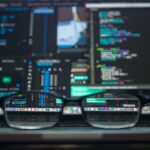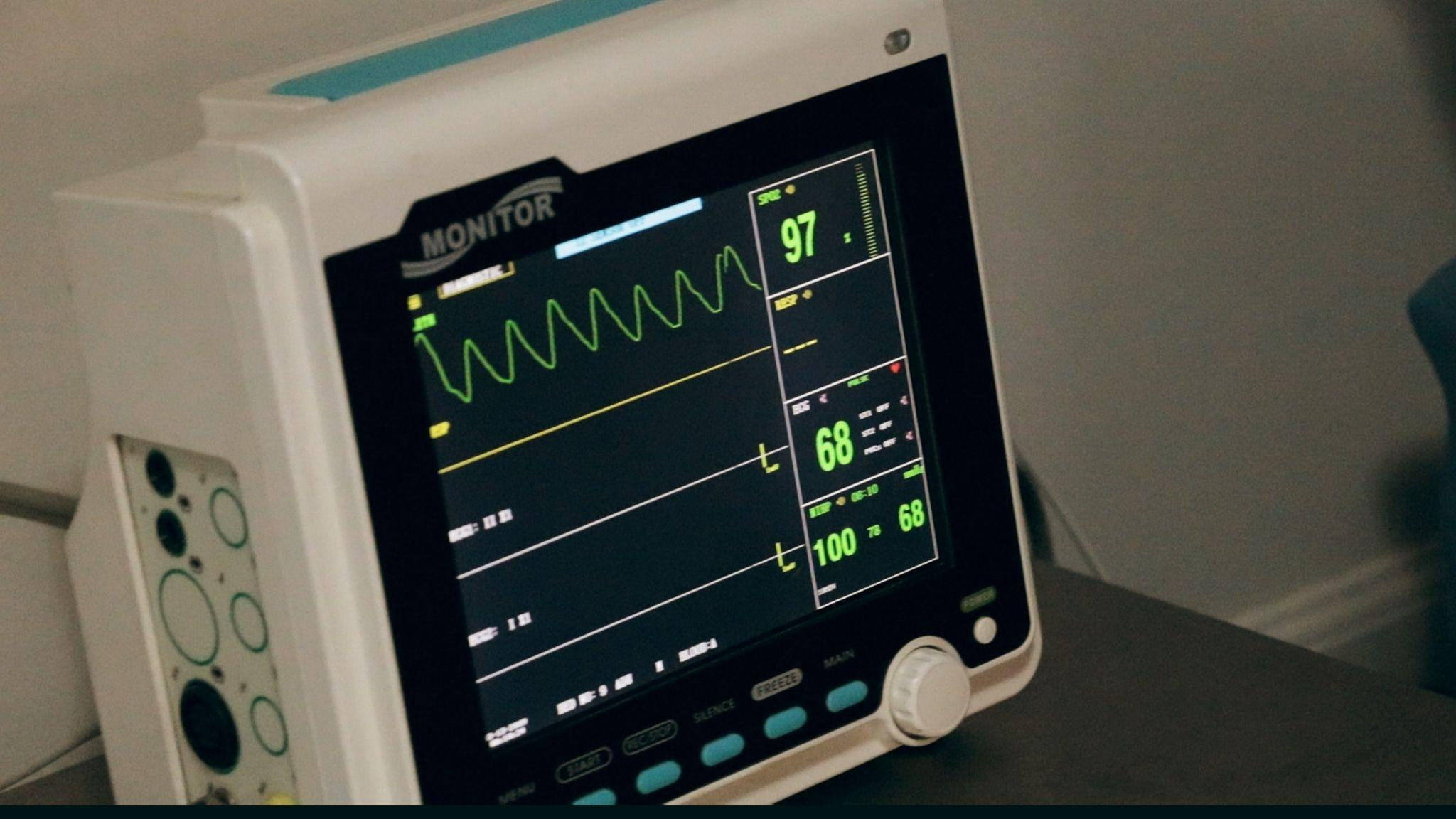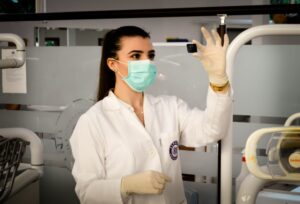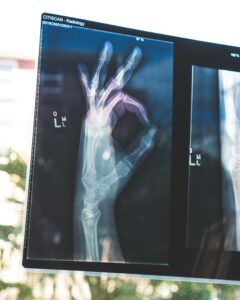Computer vision in healthcare refers to the use of computer vision algorithms and techniques to analyze medical images and data, such as X-rays, CT scans, MRIs, and videos, for the purpose of diagnosis, treatment planning, and therapy. This technology can extract important information from images and videos, such as the size, shape, position, and texture of organs, bones, and other structures in the body, as well as the presence of abnormalities or diseases.
There are several applications for computer vision in healthcare; among the most popular ones are:
1. Medical imaging analysis:
Medical imaging analysis refers to the process of interpreting and extracting meaningful information from medical images, such as X-rays, CT scans, and MRIs. This can include identifying and diagnosing diseases or abnormalities, measuring and tracking changes in the body over time, and guiding surgical or therapeutic interventions. The process can be performed manually by radiologists or other medical professionals, or with the aid of computer algorithms and software. Machine vision techniques are able to identify and diagnose diseases by analyzing medical pictures like X-rays, CT scans, and MRIs.
2. Surgical assistance:
Surgical assistance refers to the support provided by a trained professional during a surgical procedure. This can include tasks such as holding and positioning surgical instruments, providing hemostasis (control of bleeding) and retracting and exposing the surgical field. The person providing assistance is known as a surgical assistant and may be a physician assistant, nurse, or surgical technologist, depending on the scope of the procedure. In some cases, surgical assistance can also refer to the use of technology such as robotic systems, which can be controlled by a surgeon to perform specific tasks during a procedure. computer vision can be used to control and guide robots during surgery, allowing for more precise and less invasive procedures. Computer vision can assist surgeons during operations by providing real-time information on the anatomy of the patient and the location of surgical tools.
3. Robotic surgery:
Robotic surgery, also known as robotic-assisted surgery, is a type of minimally invasive surgery in which a surgeon uses a computer-controlled robotic system to perform complex procedures with high precision and accuracy. The robotic system is equipped with tiny instruments that can reach small and confined areas of the body, such as the prostate or the heart. The surgeon sits at a console and uses hand and foot controls to manipulate the robotic arms, which are connected to the patient through small incisions. Robotic surgery can be used for a variety of procedures, including prostatectomy, hysterectomy, and cardiac surgery.
Healthcare professionals can diagnose patients more accurately and consistently by utilizing computer vision to evaluate medical photos and videos. This can result in more effective treatment and better patient outcomes.
4. Monitoring and diagnosis of chronic diseases:
Monitoring and diagnosis of chronic diseases refer to the ongoing process of identifying, evaluating, and managing long-term health conditions. This can include conditions such as diabetes, heart disease, cancer, and chronic obstructive pulmonary disease (COPD). Monitoring typically involves regular check-ups and tests to assess the patient’s symptoms, track the progression of the disease, and monitor the effectiveness of treatment. Diagnosis, on the other hand, is the process of identifying a specific condition based on the patient’s symptoms, medical history, and test results. Effective monitoring and diagnosis of chronic diseases require a comprehensive approach that takes into account the patient’s overall health, lifestyle, and environment, as well as the specific characteristics of the disease. This often involves a team of healthcare professionals, including primary care physicians, specialists, nurses, and other support staff, who work together to develop and implement a personalized treatment plan. Advanced technology and telemedicine also play an important role in the monitoring and diagnosis of chronic diseases, enabling remote monitoring, data collection, and communication between patients and healthcare providers. . Feature extraction has the potential to monitor a patient’s development in chronic conditions like diabetes and heart disease by evaluating images of the patient’s eyes, skin, and other organs.
5. Pathology analysis:
Pathology analysis refers to the examination of samples of body tissue, blood, and other bodily fluids, to determine the cause and nature of the disease. The sample is typically examined under a microscope by a pathologist, who is a physician trained in the interpretation of laboratory tests and diagnostic imaging as well as the recognition of disease patterns. This examination can also be done with the aid of advanced technology such as imaging analysis, chemical analysis, and genetic testing. Pathology analysis can be used to diagnose disease, monitor treatment response, and assess the progression of the disease.
There are several types of pathology analysis including Cytology: the examination of cells and tissues Histology: the examination of tissue samples
Hematology:
the examination of blood samples Microbiology: the examination of microorganisms such as bacteria, viruses, and fungi Forensic pathology: the examination of tissue samples in legal context Veterinary pathology: the examination of animal tissue samples Pathology analysis results are critical for a wide range of medical decisions, including diagnosis, treatment, and disease management.
Pathology photos can be examined using computer vision to identify and categorize diseases like cancer.
6. Medical record analysis:
Medical record analysis refers to the process of reviewing and interpreting the information contained in a patient’s medical records. This includes data such as medical history, laboratory results, diagnostic imaging, and treatment plans. Medical record analysis can be done manually by healthcare professionals, such as physicians, nurses, and other clinicians, or with the aid of computer algorithms and software. The main goal of medical record analysis is to extract useful information that can be used to improve patient care, including diagnosis, treatment, and disease management. This can involve identifying patterns and trends in the data, such as changes in vital signs, symptoms, or lab results over time, or comparing the patient’s current condition to previous medical history. Medical record analysis is also used for research purposes, such as identifying risk factors for certain diseases, evaluating the effectiveness of treatments, and developing new diagnostic and therapeutic approaches. It’s also used for administrative purposes like billing, coding, and quality improvement. Electronic medical records can be analyzed using computer vision to find patterns and trends that can aid in diagnosis and treatment.
7. 3D modeling:
3D modeling is the process of creating a virtual representation of an object or a scene using specialized software. This representation can be used for a variety of purposes, such as animation, product design, architectural visualization, and medical simulation. In 3D modeling, an artist or designer creates a digital model by defining the shape, size, texture, and other properties of an object. This is done using a variety of tools and techniques, such as polygons, splines, and NURBS (Non-Uniform Rational B-Splines). The resulting model is a collection of points in 3D space, known as a mesh, that can be manipulated and rendered to create a final image or animation. 3D modeling can be used in various fields like video games, film and animation, product design, architecture, engineering and construction, automotive design, interior design, advertising, and medical and scientific visualization. In the medical field, 3D modeling can be used to create virtual models of internal organs, bones, and other structures, which can be used for surgical planning, patient education, and simulation training
In order to plan operations, radiation therapy, and other treatments, computer vision can be used to construct 3D models of the body’s organs and other components.
8. Medical device monitoring:
Medical device monitoring refers to the process of tracking and analyzing the performance and usage of medical devices, such as pacemakers, defibrillators, insulin pumps, and implantable cardioverter-defibrillators (ICDs). This can include monitoring the device’s battery life, electrical output, and other functional parameters, as well as tracking the patient’s physiological responses to the device. Medical device monitoring can be done in real-time, where the device sends data to a monitoring system or a healthcare provider, or by collecting data from the device at regular intervals for later analysis. The data can be used to detect and diagnose problems with the device, such as malfunctions or battery depletion, and to alert healthcare providers to potential issues before they become critical. The monitoring can be done remotely, enabling healthcare providers to monitor patients remotely and check on the performance of the device without having the patient come to the clinic. This can be especially useful for patients with chronic conditions or those who live in remote areas. Medical device monitoring can also be used to optimize device settings and improve patient outcomes, as well as to track usage patterns and evaluate the overall effectiveness of the device. Medical equipment like ventilators and heart monitors can be observed by computer vision to make sure they are operating properly.
9.Internet of Medical Things (IoMT):
The Internet of Medical Things (IoMT) refers to the use of interconnected devices and technologies in healthcare, including sensors, wearables, medical devices, and medical equipment, that can collect, transmit, and analyze data. These devices are connected to the Internet and can communicate with each other and with healthcare providers, enabling the collection and sharing of real-time data on patients’ health status and treatment outcomes. IoT devices can be used to monitor vital signs, such as heart rate, blood pressure, and blood glucose levels, and to track activity levels, sleep patterns, and other health-related metrics. This data can be used to identify trends and patterns, such as changes in health status over time or in response to treatment, and to alert healthcare providers to potential issues. The IoT can also be used to improve the efficiency and effectiveness of healthcare delivery, enabling remote monitoring, telemedicine, and the integration of data from multiple sources. This can help to reduce costs, improve patient outcomes, and increase access to care for patients in remote or underserved areas. I can also be used to support medical research, drug development, and clinical trials, by providing large and diverse sets of data from patients’ real-world experiences.
IoT devices, such as wearables and sensors, are being used to monitor patient vital signs and track health data, this allows for remote monitoring and early detection of potential health issues.
10. Assistive technology:
Assistive technology (AT) refers to any device, software, or service that is used to enhance the ability of individuals with disabilities to perform tasks and activities. It can range from simple, low-tech solutions such as modified kitchen utensils, to high-tech devices such as speech recognition software and powered wheelchairs. The goal of AT is to help people with disabilities to achieve greater independence, productivity, and enjoyment in their daily lives. There are several types of assistive technology, including Adaptive equipment for daily living: These are devices that can help people with disabilities to perform everyday tasks such as dressing, eating, or using the bathroom. Examples include adapted utensils, adaptive switches, and specialized computer hardware and software. Mobility devices: These are devices that can help people with mobility impairments to move around independently, such as wheelchairs, scooters, and walkers. Communication devices: These are devices that can help people with communication impairments to express themselves, such as speech-generating devices, adaptive keyboards, and specialized software. Environmental control units: These are devices that can help people with disabilities to control their environment, such as remote-controlled lighting, thermostats, and appliances. Assistive technology can be used by people of all ages and with a wide range of disabilities and can be customized to meet the specific needs of the individual. It can be used in various settings, including home, school, workplace, and community. People with visual impairments can use assistive technology, such as smart glasses, to navigate their environment and read text.
11. Dental imaging:
Dental imaging refers to the use of various imaging techniques to create visual representations of the teeth, jaws, and surrounding structures in the oral and maxillofacial region. This can include techniques such as X-rays, CT scans, and MRIs, as well as specialized dental imaging modalities such as cone-beam CT (CBCT) and digital radiography. Dental imaging is typically used for diagnostic and treatment planning purposes. For example, it can be used to detect cavities, periodontal disease, and other oral health problems; to evaluate the position and development of teeth and jaws; and to plan for orthodontic treatment, dental implants, and other procedures. Dental imaging can also be used to assess the results of treatment, such as the healing of bone after a dental implant procedure. Dental imaging has many advantages over traditional imaging techniques. For example, digital radiography reduces radiation exposure for patients and dental staff and allows for easy storage and retrieval of images. Cone-beam CT (CBCT) allows for 3D imaging of the jaws and teeth, providing more detailed and accurate information than traditional 2D X-rays. The use of dental imaging technology has greatly improved the diagnostic and treatment capabilities of dentistry, allowing for more precise and efficient care, as well as better patient outcomes.
Dental photos, like X-rays, can be examined using computer vision to find and diagnose dental issues.
12. Ophthalmology:
Ophthalmology is the branch of medicine and surgery that deals with the diagnosis and treatment of eye disorders and diseases. Ophthalmologists are medical doctors or doctors of osteopathy who have completed specialized education and training in the diagnosis and treatment of eye conditions, including both medical and surgical treatments. Some common ophthalmologic conditions include Refractive errors: such as myopia (nearsightedness), hyperopia (farsightedness), and astigmatism. Cataracts: a clouding of the eye’s natural lens, which can cause blurry vision and glare. Glaucoma: a group of conditions that damage the optic nerve and can lead to blindness. Age-related macular degeneration: a deterioration of the macula, which can cause loss of central vision. Diabetic retinopathy: a complication of diabetes that can cause damage to the blood vessels in the retina, leading to vision loss. Dry eye: a condition that occurs when the eyes do not produce enough tears or produce poor-quality tears, leading to discomfort and vision problems. Ophthalmologists use a wide range of diagnostic tools, including visual acuity tests, tonometry, funduscopy, and imaging tests such as ultrasound, CT, and MRI. They also use a variety of treatment methods, including medications, laser therapy, and surgery. Ophthalmology is a rapidly evolving field and new technologies, such as advanced imaging, genetic testing, and gene therapy, are increasingly being used to diagnose and treat eye disorders.
Automation has the ability to determine and treat eye problems like glaucoma or diabetic retinopathy by examining photographs of the eye, such as retinal scans.
13. Biometrics:
Biometrics is the use of unique physical or behavioral characteristics to identify and authenticate individuals. These characteristics can include fingerprints, face, iris, voice, signature, and even gait. Biometrics is used in a wide range of applications, including security, access control, and identification. There are two main types of biometrics: Physiological biometrics: These are based on the individual’s physical characteristics, such as fingerprints, face, iris, and voice. Behavioral biometrics: These are based on the individual’s unique behavioral characteristics, such as signature, gait, and keystroke dynamics. Biometric systems use sensors to acquire data from the individual and then use specialized software to extract unique features from the data and match them against a reference template. The reference template is typically stored in a database and can be used for comparison during the authentication process. Biometric systems can be used for various purposes such as Physical access control: to secure buildings, rooms, and other restricted areas. Logical access control: to secure computer systems, networks, and applications. Border control and immigration: to verify the identities of travelers at border crossings and airports. Criminal identification: to assist in the identification of suspects and criminals. Biometrics has a lot of advantages over traditional forms of identification like usernames and passwords, as biometric data is unique to an individual and cannot be lost, forgotten, or stolen like a password.
Multimodal biometric techniques like facial recognition that use computer vision can be used to identify patients and enhance patient care.
14. Radiology:
Radiology is the medical specialty that uses imaging techniques such as X-rays, CT scans, MRIs, ultrasound, and other techniques to diagnose and treat diseases and injuries. Radiologists are medical doctors who specialize in interpreting medical images and using them to diagnose and treat patients. They work closely with other healthcare professionals, such as primary care physicians and specialists, to provide an accurate diagnosis and develop a treatment plan. Radiology plays a vital role in the diagnosis and treatment of many different types of diseases and injuries. Some common conditions that are diagnosed and treated using radiology include Cancer: Radiology can be used to detect and diagnose cancer, as well as to monitor the progression of the disease and the effectiveness of treatment. Cardiac disease: Radiology can be used to evaluate the heart and blood vessels, including the detection of blocked or narrowed blood vessels and heart defects. Orthopedic injuries: Radiology can be used to diagnose and evaluate injuries to bones, joints, and other musculoskeletal structures. Gastrointestinal disorders: Radiology can be used to evaluate the digestive system, including the stomach, intestines, and colon. Neurological disorders: Radiology can be used to evaluate the brain and spinal cord, including the detection of tumors, blood clots, and other conditions. Radiology has advanced significantly over the years, allowing for more accurate and detailed images, as well as non-invasive procedures. Additionally, advances in technology have allowed for faster, more efficient, and more comfortable exams for patients.
To recognize and identify diseases, computer vision can be used to evaluate images from radiography, such as X-ray, CT, and MRI scans.
15. Telemedicine:
Telemedicine is the delivery of healthcare services remotely using telecommunication technology, such as video conferencing, remote monitoring, and electronic communications. This allows patients to receive medical consultation, diagnosis, and treatment without the need to physically visit a healthcare provider. Telemedicine can also be used to provide healthcare to individuals in remote or underserved areas. . Technology can be utilized to provide remote healthcare services like X-ray interpretation and skin disease detection by looking at images and video.









